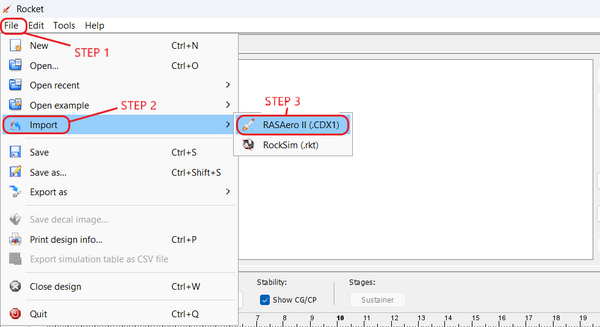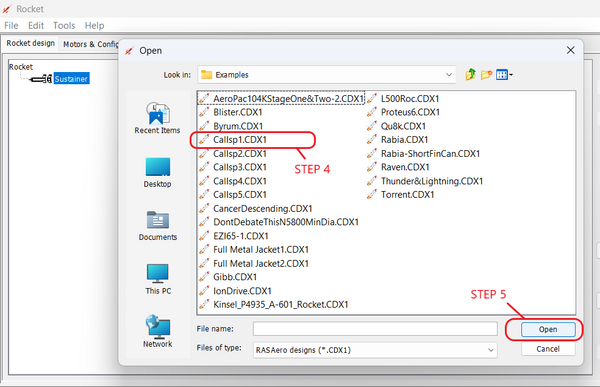Importing and Exporting to Other Applications
|
The current User's Guide is very much a work in progress, any help would be greatly appreciated! |
Overview
INSERT TEXT. . .
RASAero II
RASAero II (often simply caller RASAero) is available from Rogers Aeroscience, copyrighted as RASAero Aerodynamic Analysis and Flight Simulation Software by Charles E. Rogers and David Cooper.
RASAero is a combined aerodynamic analysis and flight simulation software package for model rockets and high power rockets, amateur rockets, and sounding rockets that is single and multi-stage capable. RASAero supports nested upper stages (an upper stage motor which slides into the booster using a "boattail" component) and features protuberance drag models for missile raceways, camera shrouds, fin brackets, and so on. RASAero can also be used for predicting aerodynamic coefficients for use in other flight simulation programs for orbital rockets.
The RASAero aerodynamic prediction methods are purported to be the most accurate available for model, high power, and amateur rockets, and are said to be of equivalent accuracy to professional engineering method aerodynamic analysis codes used for missiles, sounding rockets, and space launch vehicles.
Basic Structure
The RASAero basic structure requires a very specific architecture which must be followed if a design is to be imported from or exported to RASAero. Because OpenRocket is capable of importing more complex structures than what it can export, the rules governing the OpenRocket RASAero import and export features will be discussed with more particularity in those subsections.
With that in mind, a design file created with RASAero only has the external dimensions of the airframe without any internal components (except up to two parachutes). RASAero does not know or use internal or individual external component characteristics, such as wall thickness, material used, or density or weight. At the time the motor is selected, the user is expected to measure and provide the loaded center of gravity and loaded weight of the vehicle at that stage.
As for recovery devices, RASAero allows up to two parachutes; no streamers or other decent devices. To have any recovery event at all, Recovery Event 1 MUST occur at Apogee and MUST be a parachute. If either condition is not met, no recovery event will occur, not the first recovery event and not the second recovery event. If there is a second recovery event, Recovery Event 2 MUST occur at Altitude, a stated altitude in feet above ground level, and MUST be a parachute. If these conditions are not met, Recovery Event 2 will NOT occur.
Although RASAero affords the user a host of other settings to more accurately predict flight characteristics and results, those settings have defaults that do not require changes before running a simulation, and RASAero and OpenRocket will pass those values to the other during the import and export process.
Import Design Architecture Differences
RASAero and OpenRocket have several material differences in component compatibilities that affect importation. The significant among these are the RASAero boattail component, rail guide types, and protuberances.
Boattails: In RASAero, a boattail is an upper stage reverse transition which slides into the next stage booster. A boattail may be used as the last component of Stage 1 (a transition may also be used as the last component). The last component of the boosters in RASAero may only be a body tube or a boattail (transitions may not be used as the last booster component). During the importation process, OpenRocket converts RASAero boattails into inline pod transitions,
Rail Guide: In RASAero, the user may choose from several types of rail guides, however, OpenRocket only supports launch lugs and rail buttons. Any other type of rail guide will be stripped from the design during the importation process.
Protuberances: RASAero allows the user to create protuberances for which it has drag models. This allows RASAero to simulate missile raceways, camera shrouds, fin brackets, and other protuberances. This feature is not supported in OpenRocket and all protuberances will be stripped from the design during the importation process.
Accessing the Import Feature
The RASAero import feature in OpenRocket is accessed from the File menu. First, left-click on File to open the drop-down menu, then left-click on Import to open the application menu, and select RASAero with a third left-cleick.
When that third left-click is made, the import file menu will open. If you are new to the RASAero import feature, you may want to navigate to the example directory that is packaged with RASAero and select one of the example designs. For this discussion, the "CalIsp1.CDX1 file was selected, then "Open was left-clicked.
Five easy steps. It's as simple as that.
Recovery Device Import Position Assumptions
Where RASAero allows the use of two recovery devices, but does not specify where the recovery devices are positioned within the airframe (a requirement in OpenRocket), the importation process attempts to use the following common position rules:
One Recovery Device
- One or more body tubes: Recovery Device 1 (Apogee) is positioned below the top of Body Tube 1.
Two Recovery Device
- One body tube: Recovery Device 1 (Apogee) is positioned below the top of Body Tube 1; Recovery Device 2 (Altitude) is positioned below the top of Body Tube 1
- Two body tubes: Recovery Device 2 (Altitude) is positioned below the top of Body Tube 1; Recovery Device 1 (Apogee) is positioned below the top of Body Tube 2
- Three body tubes: Recovery Device 2 (Altitude) is positioned below the top of Body Tube 1; Recovery Device 1 (Apogee) is positioned below the top of Body Tube 2
- Four or more body tubes: Recovery Device 2 (Altitude) is positioned below the top of Body Tube 2; Recovery Device 1 (Apogee) is positioned below the top of Body Tube 3
Export Design Architecture Differences
INSERT TEXT. . .
Accessing the Export Feature
INSERT TEXT. . .
Export Assumptions
INSERT TEXT. . .
Rocksim 10
INSERT TEXT. . .
Basic Structure
INSERT TEXT. . .
Import Design Architectural Differences
INSERT TEXT. . .
= Accessing the Import Feature
INSERT TEXT. . .
Import Assumptions
INSERT TEXT. . .
OpenRocket Export Feature
INSERT TEXT. . .
Design Architecture
INSERT TEXT. . .
Accessing the Export Feature
INSERT TEXT. . .
Export Assumptions
INSERT TEXT. . .


